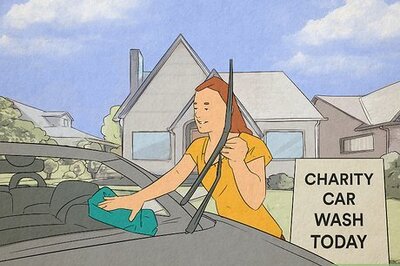
views
- On Windows 10/11, turn on Bluetooth in Settings, then put your headphones in pairing mode.
- Click your headphones from the "Available devices" list to connect.
- Take troubleshooting steps if you don't see your headphones in the list, like making sure they are charged or that Bluetooth is enabled on your computer.
Connecting
Turn on the Bluetooth headphones and put them in pairing mode. Press the "Power" button to turn on the Bluetooth headphones. The "Pairing" button's location differs on headphones, but you should see a button or switch on the side of your headphones or on the back/inside of a charging case for earbuds. Making sure they are in Pairing mode makes them discoverable for other devices. You won't see them in the devices list if they aren't in Pairing mode. Many devices have a light that pulses blue that indicates your headphones are in Pairing mode. If you don't see the light or aren't sure what lights your specific model has, you can always check the manual they came with or search online. If your headphones or earbuds aren't charged enough, they won't stay in Pairing mode long enough for you to connect to your computer.
Open Start Windows Start. Click the Windows logo in the bottom-left corner of your Windows computer to open the Start Menu.
Click Windows Settings. Click the gear icon on the left side of the Start Menu to open your PC's settings. Alternatively, press Win + I to open Settings.
Click Devices. It's the option with an icon that resembles a keyboard and a speaker near the top of the page. For Windows 11 users, this will say "Bluetooth & devices" and you can skip the next step.
Click Bluetooth & other devices. It's the first option in the sidebar menu below "Devices".
Ensure Bluetooth is turned on. The toggle switch at the top of the "Bluetooth & other devices" menu should be colored blue and say "On" to the right. If it is not, click the toggle switch to ensure Bluetooth is turned on. You can also turn on Bluetooth quickly by clicking the tile in quick settings/Action Center, which you can find in your taskbar. If you don't see this toggle, your computer may not have or support Bluetooth. You can instead purchase a dongle that goes into a USB port that accepts Bluetooth signals.
Click + Add Bluetooth or other device. It's at the top of the page and opens the "Add a device" pop-up window in the middle of the screen.
Click Bluetooth. It is the first option at the top. Your computer will start scanning for nearby devices that are in pairing mode.
Click your headphones when they appear. While scanning, if you enabled your headphones correctly, their name should appear in the "Add a device" pop-up window. This initiates the pairing and connects to your headphones. For most connections, you don't need a PIN, but if you do, you can find your model's specific PIN in the manual it came with or by searching online. It will also let you know what to do if the PIN you're trying doesn't work.
Click Done. It's a gray button at the bottom of the pop-up window. Your headphones are now connected via Bluetooth. If your headphones are connected but you aren't hearing any sound, click the volume icon in the bottom-right corner of the screen (in your taskbar) and look to see what sound device is currently selected. If your headphones are not currently selected, click the connected device and select your headphones instead. You can also right-click on the icon and select open Sound settings to change your audio output and sound settings.
Using Swift Pair
Put your headphones in Pairing mode. Press the "Pairing" button or toggle the switch to make your headphones or earbuds discoverable.
Enable Bluetooth on your computer. Click the Bluetooth tile in the Action Center in your taskbar to turn on Bluetooth.
Click Yes or Connect on your computer. If the headphones feature Swift Pair, you'll see a pop-up on your computer screen that you can connect your devices. If it's your first time using Swift Pair, click Yes to receive notifications. Swift Pair simplifies the pairing steps so you don't need to go to the "Add Bluetooth device" menu in Settings.
Troubleshooting
Restart the pairing process. If your Bluetooth headphones or earbuds did not appear in the list as discoverable devices, restart the process and try again. Turn off Bluetooth on your computer to reset the connection.
Make sure your wireless headphones are fully charged. Some headphones and earbuds will give you a "Connection Failed" error if they don't have enough charge.
Move your devices closer together. Make sure your headphones are no more than 3 feet (0.91 m) apart from your computer. This is the best range for Bluetooth to work, and having your headphones or earbuds further than 3 feet away can also give you a "Connection Failed" error. Staying within 3 feet will ensure a stronger Bluetooth signal and make it easier to connect them.
Disconnect all paired devices. Although your computer's manual suggests having multiple Bluetooth connections, having too many paired devices could prevent you from adding another device. In that case, you wouldn't see your headphones in the list of available devices.
Update your drivers on Windows 10/11. If you don't see the Bluetooth icon or can't click the toggle to turn it on, especially after an update, you might have out-of-date drivers. Update your drivers using the Windows Device Manager or files from your computer's manufacturer.
Use the Windows Bluetooth Troubleshooter. If nothing works to fix your issue, go to Start > Settings > Update & Security > Troubleshoot > Bluetooth (Find and fix other problems) > Run the troubleshooter. This is more computer-specific and should tell you what is wrong.

















Comments
0 comment